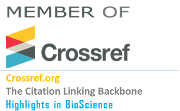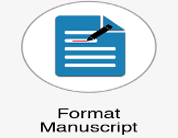The Art of Bioinformatics Learning in Our Arabic World
Abstract
Keywords
Full Text:
View Full TextReferences
Welch L, Lewitter F, Schwartz R, Brooksbank C, Radivojac P, Gaeta B, et al. Bioinformatics curriculum guidelines: toward a definition of core competencies. PLOS Comput Biol. 2014;10(3):e1003496.
Bansal AK. Bioinformatics in microbial biotechnology--a mini review. Microb Cell Fact. 2005;4(1):19.
Escobar-Zepeda A, de León A, Sanchez-Flores A. The road to metagenomics: from microbiology to DNA sequencing technologies and bioinformatics. Front Genet. 2015;6:348.
Larson RS, Oprea TI. Bioinformatics and Drug Discovery. Springer; 2006.
Fernald GH, Capriotti E, Daneshjou R, Karczewski KJ, Altman RB. Bioinformatics challenges for personalized medicine. Bioinformatics. 2011;27(13):1741–8.
Larranaga P, Calvo B, Santana R, Bielza C, Galdiano J, Inza I, et al. Machine learning in bioinformatics. Brief Bioinform. 2006;7(1):86–112.
Omondiagbe DA, Veeramani S, Sidhu AS. Machine Learning Classification Techniques for Breast Cancer Diagnosis. In: IOP Conference Series: Materials Science and Engineering. 2019. p. 12033.
Villanueva-Meyer JE, Chang P, Lupo JM, Hess CP, Flanders AE, Kohli M. Machine learning in neurooncology imaging: from study request to diagnosis and treatment. Am J Roentgenol. 2019;212(1):52–6.
Ballester PJ. Machine Learning for Molecular Modelling in Drug Design. Multidisciplinary Digital Publishing Institute; 2019.
Yamamoto K. Distillation of crop models to learn plant physiology theories using machine learning. PLoS One. 2019;14(5):e0217075.
Filippi P, Jones EJ, Wimalathunge NS, Somarathna PDSN, Pozza LE, Ugbaje SU, et al. An approach to forecast grain crop yield using multi-layered, multi-farm data sets and machine learning. Precis Agric. 2019;1–15.
Zhi Q, Saitoh T, Nakajima M, Saitoh T. A development of content-based video summarization system using machine-learning and its application to analysis of livestock behavior. In: International Workshop on Advanced Image Technology (IWAIT) 2019. 2019. p. 1104911.
Hadidi MS, Al Khateeb JM. Special education in Arab countries: Current challenges. Int J Disabil Dev Educ. 2015;62(5):518–30.
Loucif S. Bioinformatics in Middle East program curricula—a focus on the Arabian Gulf. Educ Inf Technol. 2014;19(2):375–82.
YouTube LLC. YouTube. Retrieved. 2011;27:2011.
Academia. Academia. Available from: https://www.academia.edu/
Dragoni N, Giaretta A, Mazzara M. The internet of hackable things. In: International Conference in Software Engineering for Defence Applications. 2016. p. 129–40.
Zastrow R. Linux Essentials. 2016;
Gamalielsson J, Lundell B. Sustainability of Open Source software communities beyond a fork: How and why has the LibreOffice project evolved? J Syst Softw. 2014;89:128–45.
Browder T. Why Linux? 2018;
Ubuntu. No Title. Available from: https://ubuntu.com/
Fedora. No Title. Available from: https://getfedora.org/
openSUSE. No Title. Available from: https://www.opensuse.org/
Red Hat. No Title. Available from: https://www.redhat.com/en
Saeki T, Nishiwaki Y, Shinagawa T, Honiden S. Bash on Ubuntu on macOS. In: Proceedings of the 8th Asia-Pacific Workshop on Systems. 2017. p. 17.
Dawson M, DeWalt B, Cleveland S. The case for UBUNTU Linux operating system performance and usability for use in higher education in a virtualized environment. 2016;
EL-Tantawy SA. Ubuntu. Port Said University; 2016.
BioLinux. No Title. Available from: http://environmentalomics.org/bio-linux/
NEBC. No Title. Available from: http://nebc.nerc.ac.uk
Carver T, Bleasby A. The design of Jemboss: a graphical user interface to EMBOSS. Bioinformatics. 2003;19(14):1837–43.
Cock PJA, Antao T, Chang JT, Chapman BA, Cox CJ, Dalke A, et al. Biopython: freely available Python tools for computational molecular biology and bioinformatics. Bioinformatics. 2009;25(11):1422–3.
Langtangen HP, Barth TJ, Griebel M. Python scripting for computational science. Vol. 3. Springer; 2006.
Moschovakis YN. What is an algorithm? In: Mathematics unlimited—2001 and beyond. Springer; 2001. p. 919–36.
Lafore R. Data structures and algorithms in Java. Sams publishing; 2017.
Chou PH. Algorithm education in Python. Proc Python. 2002;10:2.
Orwant J, Hietaniemi J, Macdonald J, MacDonald JD. Mastering algorithms with Perl. “ O’Reilly Media, Inc.”; 1999.
Gentleman R. R programming for bioinformatics. Chapman and Hall/CRC; 2008.
Okigbo EC, Osuafor AM. Effect of using mathematics laboratory in teaching mathematics on the achievement of mathematics students. Educ Res Rev. 2008;3(8):257–61.
He M, Petoukhov S. Mathematics of bioinformatics: Theory, methods and applications. Vol. 19. John Wiley & Sons; 2011.
Chatfield C. Statistics for technology: a course in applied statistics. Routledge; 2018.
Jiang R, Zhang X, Zhang MQ. Basics of Bioinformatics. Springer; 2016.
bioRxiv. bioRxiv. Available from: https://www.biorxiv.org/
Kalliamvakou E, Gousios G, Blincoe K, Singer L, German DM, Damian D. The promises and perils of mining GitHub. In: Proceedings of the 11th working conference on mining software repositories. 2014. p. 92–101.
Afgan E, Baker D, Coraor N, Goto H, Paul IM, Makova KD, et al. Harnessing cloud computing with Galaxy Cloud. Nat Biotechnol. 2011;29(11):972.
CyVerse. CyVerse. Available from: https://cyverse.org/
Maglott D, Ostell J, Pruitt KD, Tatusova T. Entrez Gene: gene-centered information at NCBI. Nucleic Acids Res. 2010;39(suppl_1):D52--D57.
Hubbard T, Barker D, Birney E, Cameron G, Chen Y, Clark L, et al. The Ensembl genome database project. Nucleic Acids Res. 2002;30(1):38–41.
Abu-Orabi ST, General S. Scientific research & higher education in the Arab world. In: CLICKS MENA Higher Education Leadership Forum. 2013. p. 12–3.
Ask Ubunut. Ask Ubunut. Available from: https://askubuntu.com/
Bioinformatics. No Title. Available from: https://www.bioinformatics.org/
Yu M-C, Wu Y-CJ, Alhalabi W, Kao H-Y, Wu W-H. ResearchGate: An effective altmetric indicator for active researchers? Comput Human Behav. 2016;55:1001–6.
Altschul SF, Madden TL, Schäffer AA, Zhang J, Zhang Z, Miller W, et al. Gapped BLAST and PSI-BLAST: a new generation of protein database search programs. Nucleic Acids Res. 1997;25(17):3389–402.
Prechelt L. An empirical comparison of seven programming languages. Computer (Long Beach Calif). 2000;33(10):23–9.
Robison AD, Dubois PF. C++ gets faster for scientific computing. Computers in Physics. 1996 Sep;10(5):458-62.
Arthur LJ. UNIX shell programming. John Wiley & Sons, Inc.; 1990.
Mitchell TM. The discipline of machine learning. Vol. 9. Carnegie Mellon University, School of Computer Science, Machine Learning; 2006.
Jordan MI, Mitchell TM. Machine learning: Trends, perspectives, and prospects. Science (80- ). 2015;349(6245):255–60.
Müller AC, Guido S, others. Introduction to machine learning with Python: a guide for data scientists. “ O’Reilly Media, Inc.; 2016.
Ortega A. Three tips to achieve academic success — while enjoying a social life. Nature. 2019
Nettle D. Schizotypy and mental health amongst poets, visual artists, and mathematicians. J Res Pers. 2006;40(6):876–90.
Fernee CR, Gabrielsen LE, Andersen AJW, Mesel T. Therapy in the open air: Introducing wilderness therapy to adolescent mental health services in Scandinavia. Scand Psychol. 2015;2.
Paluska SA, Schwenk TL. Physical activity and mental health. Sport Med. 2000;29(3):167–80.
DOI: https://doi.org/10.36462/H.BioSci.20193
Refbacks
- There are currently no refbacks.
Copyright (c) 2019 Alsamman

This work is licensed under a Creative Commons Attribution 4.0 International License.
...........................................................................................................................................................
Other "Highlights in" Journals
Highlights in Bioinformatics, Highlights in Chemistry, Highlights in Science, Highlights in Microbiology, Highlights in Plant Science
........................................................................................................................................
International Library of Science "HighlightsIn" is an Open Access Scientific Publishers, aiming to science and knowledge support













